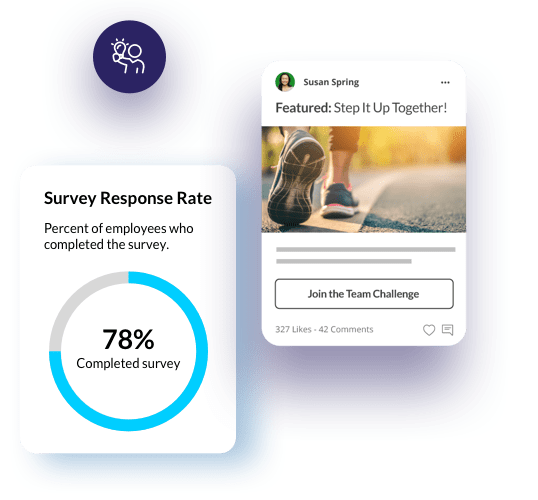The Total Economic Impact of Limeade
Cost Savings And Business Benefits Enabled By Limeade

Prior to using Limeade, organizations didn’t see the changes they were looking for in employee well-being due to technology and resource limitations. Forrester research reveals proven ROI and business benefits enabled by Limeade.
See the proof in Forrester Research’s 2022 Total Economic Study of:
- Improved employee satisfaction with Limeade led to more participation
- Flexible technology and strategic support from the Limeade Customer Success team encouraged growth and optimized investment in Limeade
- Greater participation and the ability to include other company resources increased usage of company benefits
- More informed and supported employees performed better for their customers
- A holistic well-being solution created positive behavior changes and sustained healthy habits in employees
Executive Summary
Click here to download the PDF version.
US worker engagement has been less than 33% for 15 years, and the numbers are even lower globally. Employee engagement is now, more than ever, a top corporate priority, with the goal of increasing employee happiness, well-being, and commitment to the company’s culture and business objectives. Companies that successfully drive high levels of employee engagement are far more likely to attract and retain the best talent, create market differentiation, and deliver strong customer and business outcomes.1
Limeade provides an integrated employee well-being experience that acts as a hub for content and communications related to the elements of well-being that employees care about. Limeade personalizes the employee experience by streaming content and delivering activities that match employees’ individual health and well-being goals. With Limeade, organizations acknowledge an employee as a whole person, which, according to Forrester research, fulfills an essential need for current and future employees and contributes to employee engagement and overall employee experience.
Limeade commissioned Forrester Consulting to conduct a Total Economic Impact™ (TEI) study and examine the potential return on investment (ROI) enterprises may realize when utilizing a Limeade solution.2 The purpose of this study is to provide readers with a framework to evaluate the potential financial impact of Limeade on their organizations.
To better understand the benefits, costs, and risks associated with this investment, Forrester interviewed four representatives with experience using Limeade. For the purposes of this study, Forrester aggregated the interviewees’ experiences and combined the results into a single composite organization.
Interviewees’ organizations experienced a journey related to their corporate wellness goals. Initially, the shift to a more holistic approach to wellness was viewed as a means to reduce healthcare costs by increasing employee participation in wellness programming. This included programs not only offered through Limeade but also those associated with other benefits; insurance programs; and ancillary point solutions, such as those for safety trainings, financial resources, mental health, diversity and inclusion, etc. Ultimately, however, interviewees found that treating each employee as a whole person was inherently more valuable to the organization, and heavily prioritizing healthcare cost savings became a lesser priority — and thus completing the evolution from a wellness focus to a well-being program focus.
Prior to using Limeade, these interviewees noted that previous attempts to approach wellness holistically yielded limited success due to technology and resource limitations. Organizations could not deliver varied experiences at the frequency required to meet employee needs across a broad array of topics inherent to holistic employee well-being, which included individual, environmental, and contextual components of well-being.3
After the investment in Limeade, interviewees achieved cost savings from reduced administrative burden and optimized spend on well-being. Interviewees used the platform’s flexibility to tune well-being programming to employee needs, helping them reach new levels of engagement. Interviewees found that a more engaged employee population was also a healthier and happier population that wanted to stay with their employer longer and help deliver strong business outcomes.
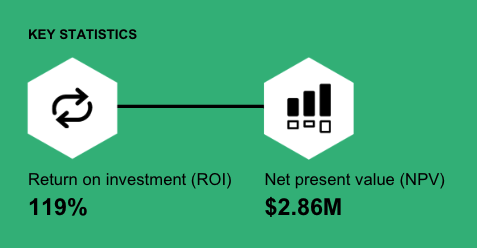
KEY FINDINGS
Quantified benefits. Three-year, risk-adjusted present value (PV) quantified benefits for the multibillion-dollar composite organization total $5.27 million and include:
- Reduction in employee attrition results in cost savings totaling $4.2 million by Year 3. Limeade transforms wellness programs by delivering well-being resources designed to promote healthy behavior changes and offering personalized streaming content and resources. All are highly relevant and aimed to meet an employee’s individual needs. As a result, employees feel more connected to their employers and stay employed longer. The investment in Limeade results in a 1.5% percentage point reduction in attrition in Year 1 that grows to a 3.5% reduction by Year 3. As a result, the organization saves $4.2 million on employee turnover related costs over the three-year investment.
- Cost savings from avoided administrative burden total $727,000. Limeade solutions offer functionality to power well-being experiences as well as tools to assist in the ongoing administration and management of those As a result, the resource burden diminishes while the organization benefits from more campaigns annually. The resulting time savings totals $727,000 over the three-year investment.
- Cost savings of $310,000 from increased benefit utilization. Limeade delivers comprehensive data and insights including third-party resources and other ancillary benefits delivered through the experience. The composite organization tracks participation levels across its entire well-being landscape to identify opportunities to double-down on popular applications and topics and divest from poor-performing investments. The total cost savings from better benefits utilization is $310,000 over three years.
Unquantified benefits. Benefits that are not quantified in this study include:
- Optimized investment in Limeade and flexible technology encouraged growth. Limeade solutions provide flexible technology and are equipped to enable many different ways to integrate with ancillary wellness-related applications and tools. When the technology was configured to incorporate these additional benefits, it collected data and provided insights on participation and reach. Additionally, Limeade consultative services offered ongoing support to help optimize the investment in Limeade.
- Improved employee satisfaction led to more platform engagement. Employees and end users enjoyed using Limeade solutions as reflected in higher satisfaction scores. As a result, employees tended to engage more with their well-being experience.
- Elevated participation in ancillary benefits. Limeade’s solutions were effective in their reach, delivering a personalized experience to each user. Interviewees were able to target audiences based on business goals and employee input via polls and surveys, resulting in higher participation in those benefits as well.
- Improved customer experiences. Better employee experiences beget better customer experiences. More informed and supported employees performed better for their customers. Forrester research indicates that at customer-obsessed firms, employees are 28% more likely to report being happy at work, which contributed to higher employee accountability, more innovation, and lower attrition, among other benefits.4
- Sustained healthy habits. The shift to a more holistic and educational well-being experience for users brought about changes in employee behaviors that encouraged healthier habits.
Costs. Three-year, risk-adjusted PV costs for the composite organization include:
- Annual costs to Limeade total $2.2 million. Fees to Limeade for technology and ongoing support via consultative services are paid on a per employee per year (PEPY) basis. The composite organization averages a $28 PEPY cost that totals $2.2 million over the three-year investment.
- Internal resource time spent on implementation and ongoing maintenance activities total $215,000. Implementation responsibilities are shared across wellness administrators and IT professionals and total one FTE’s time for three months. Additionally, three well-being administrators contribute to ongoing program administration and platform management on an ongoing basis. Finally, line-of-business champions each dedicate a small amount of time to the champion program. Internal resource time spent on the Limeade investment totals $215,000 over three years.
The representative interviews and financial analysis found that a composite organization experiences benefits of $5.27 million over three years versus costs of $2.41 million, adding up to a net present value (NPV) of $2.86 million and an ROI of 119%, with a payback period of less than six months.
“One of the things that we enjoy about Limeade is their strong personalization and the fact that they have machine learning and AI built into the platform to provide an experience that is more like a streaming service in terms of curating personalized content. Previous platforms and wellness efforts cast a wide net and tried to catch as many [participants] as possible versus really individualizing an approach to help people be at their best.”
— Wellness program manager, healthcare
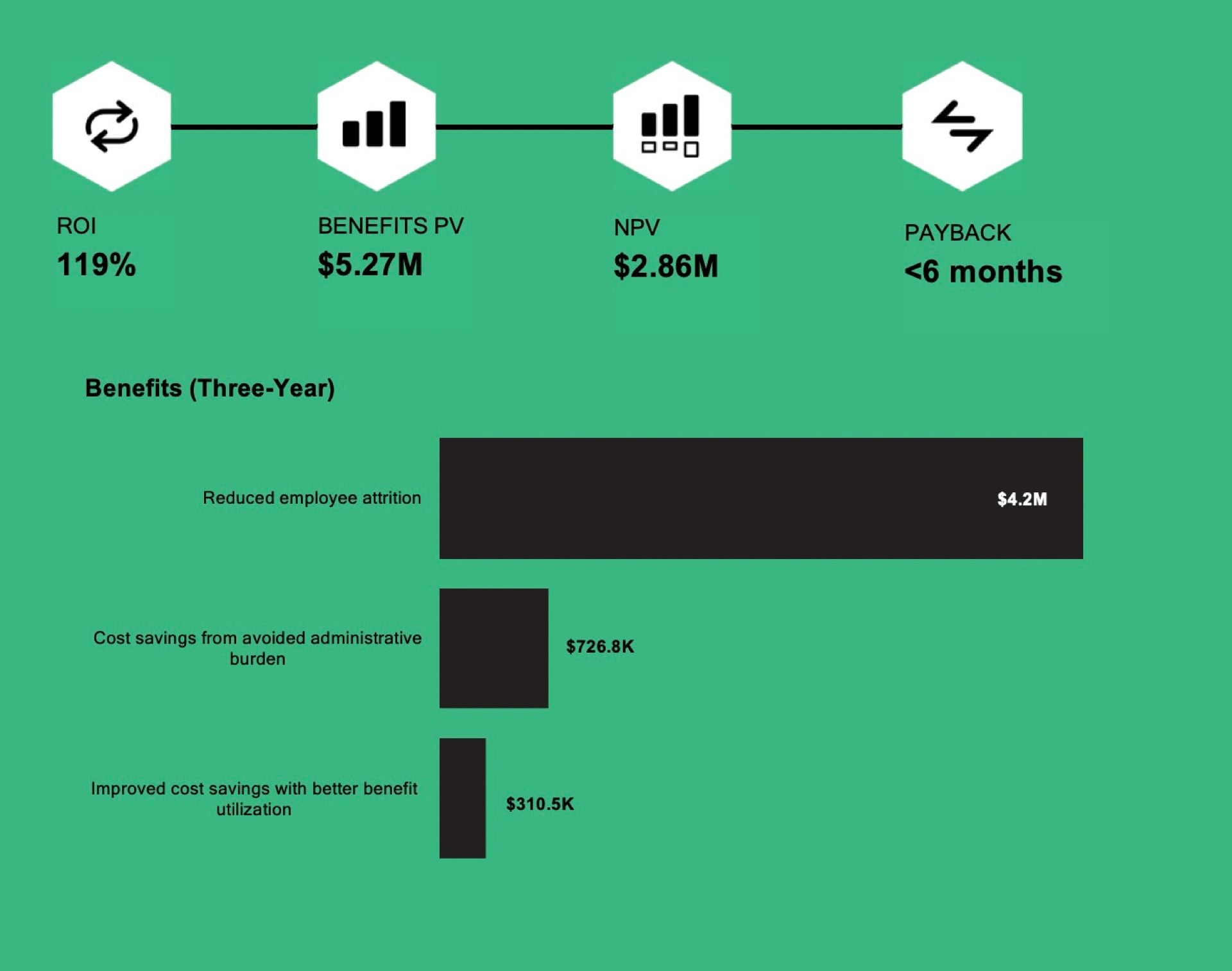
TEI FRAMEWORK AND METHODOLOGY
From the information provided in the interviews, Forrester constructed a Total Economic Impact™ framework for those organizations considering an investment in Limeade.
The objective of the framework is to identify the cost, benefit, flexibility, and risk factors that affect the investment decision. Forrester took a multistep approach to evaluate the impact that Limeade can have on an organization.
DISCLOSURES
Readers should be aware of the following:
This study is commissioned by Limeade and delivered by Forrester Consulting. It is not meant to be used as a competitive analysis.
Forrester makes no assumptions as to the potential ROI that other organizations will receive. Forrester strongly advises that readers use their own estimates within the framework provided in the study to determine the appropriateness of an investment in Limeade.
Limeade reviewed and provided feedback to Forrester, but Forrester maintains editorial control over the study and its findings and does not accept changes to the study that contradict Forrester’s findings or obscure the meaning of the study.
Limeade provided the customer names for the interviews but did not participate in the interviews.
DUE DILIGENCE
Interviewed Limeade stakeholders and Forrester analysts to gather data relative to Limeade.
INTERVIEWS
Interviewed four representatives at organizations using Limeade to obtain data with respect to costs, benefits, and risks.
COMPOSITE ORGANIZATION
Designed a composite organization based on characteristics of the interviewees’ organizations.
FINANCIAL MODEL FRAMEWORK
Constructed a financial model representative of the interviews using the TEI methodology and risk-adjusted the financial model based on issues and concerns of the interviewees.
CASE STUDY
Employed four fundamental elements of TEI in modeling the investment impact: benefits, costs, flexibility, and risks. Given the increasing sophistication of ROI analyses related to IT investments, Forrester’s TEI methodology provides a complete picture of the total economic impact of purchase decisions. Please see Appendix A for additional information on the TEI methodology.
The Limeade Customer Journey
TAKING EMPLOYEE WELLNESS BEYOND BENEFITS
According to Forrester research, modern business was tough enough, and then the pandemic ushered in the future of work today, quickly reforming how, why, and where work happens. This forced employees to be more collaborative, innovative, and adaptive than ever before — testing their individual resources. Employee well-being — the total health and wellness of workers — is the source on which they draw to perform. To thrive, organizations must go beyond the benefits they have historically provided5.
- Why is well-being important? Employees are experiencing mental strain, are physically less well than they could be, and are facing both increased work demands and unprecedented levels of social isolation. In fact, a US Centers for Disease Control and Prevention study of US adults found that anxiety symptoms tripled and depression symptoms quadrupled between 2019 and 20206. Additionally, 47% of US remote workers aren’t sure that their organization will consider well-being when making business decision relating to the pandemic7.
- What is included in holistic well-being programs? Well-Being is a concept that contains multitudes. Historically, corporate health and wellness programs focused on isolating the few dimensions of employee wellness that they were obliged to support. Forrester believes it is time to widen the aperture and see well-being for everything it includes. While the specific definition of well-being varies across organizations, Forrester sees well-being across eight specific wellness components (see figure, below).8
“[Our prior solution] wasn’t really driving changed behaviors. It wasn’t really helping folks manage stress. It wasn’t helping folks become more mentally and emotionally healthy. Participation was driven by incentives, and we wanted to move away from that being the guiding principle for our program [with Limeade].”
Senior benefits analyst, conglomerate
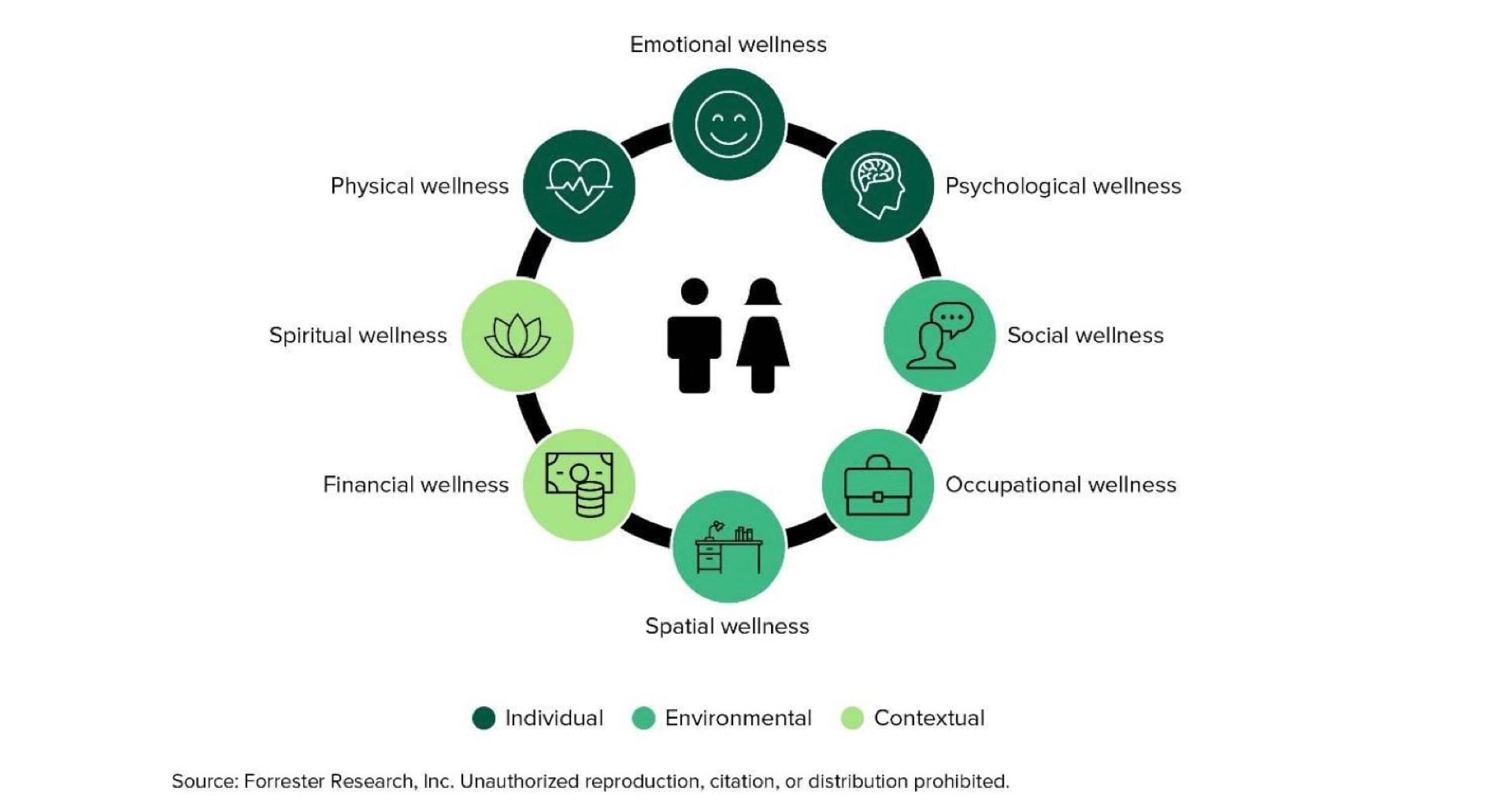
Today, only 24% of workers strongly agree with the statement, “My company is willing to invest in the health and well-being of employees.” Leaders claim that this number is so low due to the balance between doing well as a company versus doing good for employees. That’s wrong: Employees who are well simply perform better. When you invest in, support, and promote wellness across all eight subdimensions of wellness, you augment the employee’s ability and willingness to generate value.9
KEY CHALLENGES
The interviewees’ organizations aimed to shift their corporate well-being programs away from incentives-based and largely physical wellness-focused programs to a more holistic approach. However, there were a few common challenges that stood in the way of executing on that shift before they invested in Limeade, including:
- Technology challenges. Previous technology platforms and vendors that supported wellness programming were inflexible and hard to manage from an administration standpoint. Additionally, they lacked comprehensive features and functionality to meet employees where they were digitally. As a result, platforms were often configured to support the same small volume of campaigns each year and required either new statements of work or completely custom content and manual execution to update existing campaigns and/or add new ones. Interviewees’ organizations were, therefore, restricted in terms of the content variety and cadence they executed in the space.
- Program focus challenges. Given that it was extremely difficult to customize company wellness content, let alone personalize employee experiences, existing campaigns were highly generalized and lacked a target audience. Campaigns were recycled over the years and inherited dated content and formats that perpetuated both a physical wellness focus and an incentives-based format.
- Employee behavior challenges. With generalized and dated campaigns constituting the wellness program landscape, employee participation in these areas suffered. Organizations lacked the data and insights necessary to tailor programming to employee interests and therefore fell back on the same patterns each year. And without targeted and interesting content, the programs continued to require incentives to encourage participation. Thus, the cycle continued, resulting in low engagement and low participation that did not inspire long-term changes in behavior for employees.
“Over time as an organization — and in my personal education as well as my involvement in Wellness Council of America and other organizations that address employee well-being — we knew we wanted to get somewhere holistic and digital [with our wellness program]. As more and more people are working from their phones and are less likely to be tied to a computer, we strived to make something [with Limeade] that could be accessible anywhere.”
Wellness program manager, healthcare
INVESTMENT OBJECTIVES
The interviewees’ organizations searched for a solution that could:
- Enable a more holistic approach to well-being, moving beyond just physical wellness.
- Extend a modern digital presence and global capabilities (such as relevant content and translations) to enhance accessibility.
- Provide a flexible platform that enables extensions to other wellness-related platforms and solutions to become a more integrated communication and content hub.
- Offer personalized and streaming experiences with a shift in value from incentivization to education.
- Generate dashboards and reports to continuously monitor participation, fine-tune end-user experiences, and optimize spend on ancillary components of the wellness landscape.
After an RFP and business case process evaluating multiple vendors, the interviewees’ organizations chose Limeade and began deployment.
- Three out of four interviewees implemented the Limeade Well-Being solution. The remaining interviewee elected to utilize Limeade EX, the Limeade solution focused as a hub for communications, listening, and well-being resources.
- Limeade was deployed globally to employees and covered spouses in most cases, except for one interviewee whose organization deployed to covered spouses in the US only.
COMPOSITE ORGANIZATION
Based on the interviews, Forrester constructed a TEI framework, a composite company, and an ROI analysis that illustrates the areas financially affected. The composite organization is representative of the four interviewees, and it is used to present the aggregate financial analysis in the next section. The composite organization has the following characteristics:
Description of composite. The composite organization is a multibillion-dollar industry-agnostic firm with a corporate goal of increasing employee engagement. As such, it believes that investing in employee wellness is a critical component of improving employee engagement, creating a productive and happy workforce, and improving employee turnover rates.
Its 30,000 employees are spread across numerous locations globally. It was critical that the wellness platform provider could both access and interest employees from different geographical regions with personalized and relevant content.
Deployment characteristics. The composite organization adopts the Limeade Well-Being solution. And while Limeade is usually rolled out to employees and covered spouses, for purposes of the composite organization, Forrester assumes that access is granted to employees only. Additionally, Limeade is meant to function as digital navigation for the organization by becoming the nexus between employees and the well-being content they care about, including Limeade content; insurance and benefits content; and other point solutions that cover physical, mental, emotional, or financial well-being.
Limeade participation is a metric that measures the percentage of individuals with access to the Limeade platform who created an account. While the Limeade participation percentage is not a static number, for purposes of the financial analysis, Forrester assumes that Limeade active participation averages 45% across the three-year investment.
From an administrative standpoint, the organization maintains the same three FTEs who participate in wellness administration while simultaneously delivering more benefits and employee activities and programs annually. It also establishes an effective champion network that takes small amounts of business leader and manager time to spread wellness across the organization and further drive impact.
Key Assumptions
- 30,000 employees
- 3 wellness administrators
- 45% average Limeade active participation
- 50 champions in line of business (LOB)
Analysis Of Benefits
REDUCED EMPLOYEE ATTRITION
Evidence and data. Forrester research states that the more engaged employees are, the more likely they are to stay for at least the next 12 months. By better enabling employees for success and improving the overall engagement of their employees, employers will find better retention results, which in turn can have a positive effect on overall business outcomes.10
Additionally, Forrester’s Workforce Survey shows that disengaged employees are 12 times more likely to leave in the next 12 months than engaged employees: 36% of disengaged global information workers said they would leave, versus 3% of engaged ones.11
- A senior benefits analyst at a conglomerate organization saw an improvement in participation in ancillary benefits. Higher participation rates demonstrated that employees were taking advantage of existing benefits and in doing so felt more informed and supported. The senior benefits analyst at a conglomerate linked these qualitative improvements to a reduction in employee turnover: “The number one thing that we hear is when the benefits offerings are good, employees feel secure and cared for and are more likely to stay than they are to leave. [A third-party consulting firm we engaged] found that our employees feel that we are doing well in the well- being arena, and that is a reason to stay. It makes a big difference.”
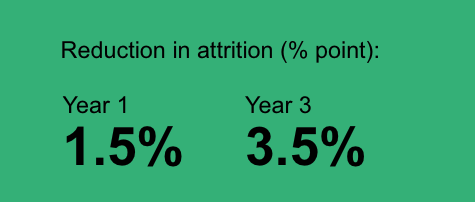
- A reduction in employee attrition became even more important amid a highly competitive job market, where organizations risked turnover not only from unhappy employees but also happy employees with more choices regarding job options.
- Interviewees also experienced higher satisfaction ratings with their Limeade solution itself versus legacy wellness The manager of wellness at a professional services organization noted that Limeade satisfaction ratings jumped by at least 1 point on a 5-point scale when compared to prior solutions: “Our satisfaction rating with our previous vendor, I don’t know if we ever got above a 3.7 out of 5. And with Limeade, now at the end of our third year, we are at a rating of 4.5 out of 5.”
- The manager of wellness at a professional services organization credited Limeade content variety and customization opportunities for the higher satisfaction rates among end users.
“Employees enjoy having more control over what they can focus on for their own well-being versus being told where to focus and being offered limited areas of focus. I see a higher level of satisfaction from employees when they are driven by intrinsic motivation or satisfaction from what they accomplished versus checking off a to-do list that someone else gives them.”
Manager of wellness, professional services
- A director of communications and content at a healthcare organization expressed that more-informed employees often felt a deeper connection to their employer and its leaders. This connection tied employees to their organizations and encouraged them to contribute to higher business goals.
Modeling and assumptions. For the purposes of the composite, Forrester makes the following assumptions:
- This benefit is isolated to the percentage of employees who engage with their Limeade solution. Of the 30,000 total employees who have access to Limeade, 45% have created an account and are considered participating actively in the platform.
- The composite organization believes in a holistic approach to well-being and is conducting other initiatives outside of the Limeade solution to support employees. Therefore, annual attrition rates fall for all employees each year of the analysis, starting at 15% in Year 1 and reducing to 14% by Year 2 and 5% by Year 3.
- The percentage-point reduction in attrition experienced after implementing Limeade is representative of additional reductions in attrition that are attributable to the Limeade platform and apply only to Limeade participants.
- The cost associated with employee attrition is calculated as 20% of the average fully burdened salaries associated with the impacted employees.
- Additionally, there is some self-fulfillment present in that the nature of the employees who choose to participate in the Limeade experience are typically committed to their well-being as individuals outside of the Limeade platform. Therefore, only 40% of this total benefit is attributed to Limeade.
Risks. Reduced employee attrition may vary depending on:
- The commitment of both the organization and the individual employees to well-being outside of the Limeade investment.
- The average fully burdened salaries for impacted employees and the typical cost of turnover to the organization.
Results. To account for these risks, Forrester adjusted this benefit downward by 5%, yielding a three-year, risk-adjusted total PV (discounted at 10%) of $4.2 million.
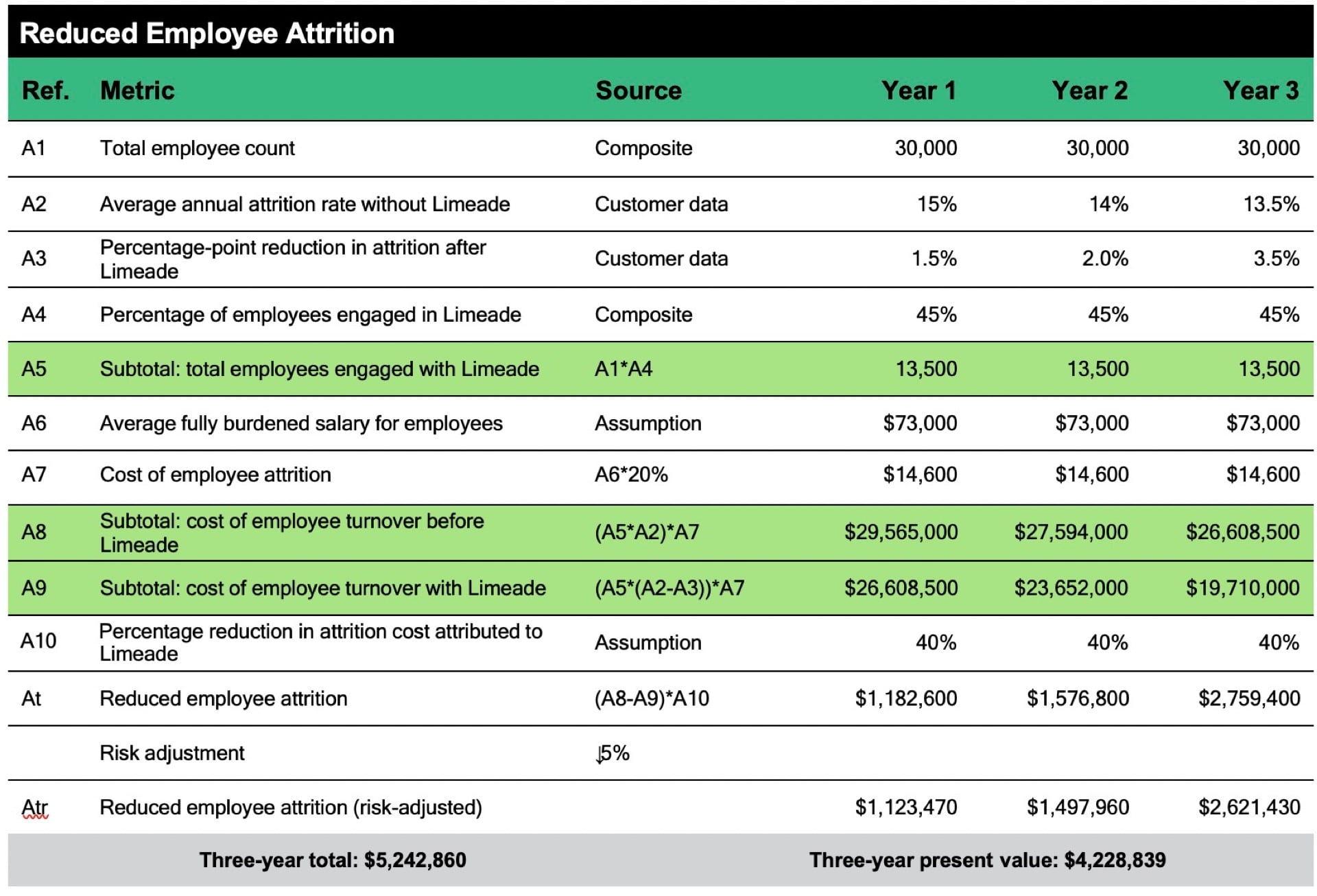
COST SAVINGS FROM AVOIDED ADMINISTRATIVE BURDEN
Evidence and data. Prior to the engagement with Limeade, interviewees were restricted by both resource bandwidth and legacy technology in terms of how quickly and easily they could create and publish wellness content such as campaigns, events, and activities. Therefore, they were often forced to narrow the scope of their operations- typically to physical wellness campaigns delivered on a very limited cadence and repeated annually. Limeade has built a streamlined approach to delivering an effective well-being experience, which empowered administrators to build the types of programs that delivered on employee needs, without adding to the administrative burden required to run those programs. Limeade also offered tools for ongoing management and administration that further contributed to output capabilities. Additionally, Limeade highlighted opportunities to scale the investment by distributing the impact across the organization through line-of-business champions.
- A wellness program manager at a healthcare organization credited the Limeade tools with creating additional efficiencies for wellness program administrators. They stated, “Limeade has a lot of features that benefit our employees but also benefit us as an organization in terms of trying to manage the effort”.
- A senior benefits analyst at a conglomerate described the benefit associated with what Limeade calls the “champion network.” Essentially, leaders from across the organization dedicated very small amounts of time to well-being program management by assisting in planning and logistics for certain events, such as onsite biometric screenings, or simply by communicating about upcoming campaigns, activities, events, etc. to their business units. In this way, the dedicated wellness program administrators achieved greater proliferation throughout the organization without the associated time burden. The senior benefits analyst stated: “There are employee efficiencies in program administration for both benefits administrators as well as the wellness champions spread throughout the organization. We have been able to reduce time spent but increase effectiveness. The result is that we avoid hiring to support our total volume of employees.”
- The same senior benefits analyst from a conglomerate further elaborated, stating that they have been able to maintain the same number of FTEs dedicated to wellness administration and lessen the burden on champions while simultaneously delivering on at least 240 activities a year, whereas before they could only do 10 to 15 activities annually.
Modeling and assumptions. For the purposes of the composite, Forrester makes the following assumptions:
- With the investment in the Limeade solution, there is a fundamental shift from enterprise “wide-net” campaigns driven by incentivization to personalized streaming content and activities. As such, the definition of a “campaign” drastically changes after leveraging a Limeade solution.
- Campaigns launched using a Limeade solution annually represent enterprise-level campaigns comparable to those in the prior state as well as myriad other activities and events of varying sizes and scopes. Therefore, campaign volume per year is an average number inclusive of everything from large, enterprise-level campaigns to small, targeted activities.
- Additionally, the level of personalization and quality experienced with a Limeade solution would not have been possible in the prior state given the resource and technology constraints. To account for these improvements, Forrester accounts for 30 additional hours per campaign.
- Forrester assumes that the average fully loaded hourly rate for wellness administrators is $53, and the associated annual salary would be about $110,000. Therefore, the avoided administrative burden can be viewed as avoided FTEs either hired or reallocated from other areas of the organization to run wellness campaigns without Limeade.
- In Year 1, the total cost savings of $213,060 is the equivalent of avoiding an additional two FTEs’ time dedicated to wellness campaigns.
- In Year 2, the total cost savings of $332,310 is the equivalent of avoiding dedicating an additional FTEs to wellness campaigns, totaling three FTEs.
- By Year 3, the total cost savings of $451,560 is the equivalent of avoiding dedicating additional FTEs to wellness campaigns, totaling four FTEs.
Risks. Cost savings from avoided administrative burden may vary depending on the following:
- The definition and cadence of campaigns produced in the prior state as well as the volume of resources and level of technology supporting those campaigns.
- Fully burdened hourly rates for wellness program administrators varies depending on seniority of those involved as well as regional salary standards.
Results. To account for these risks, Forrester adjusted this benefit downward by 10%, yielding a three-year, risk-adjusted total PV of $727,000.
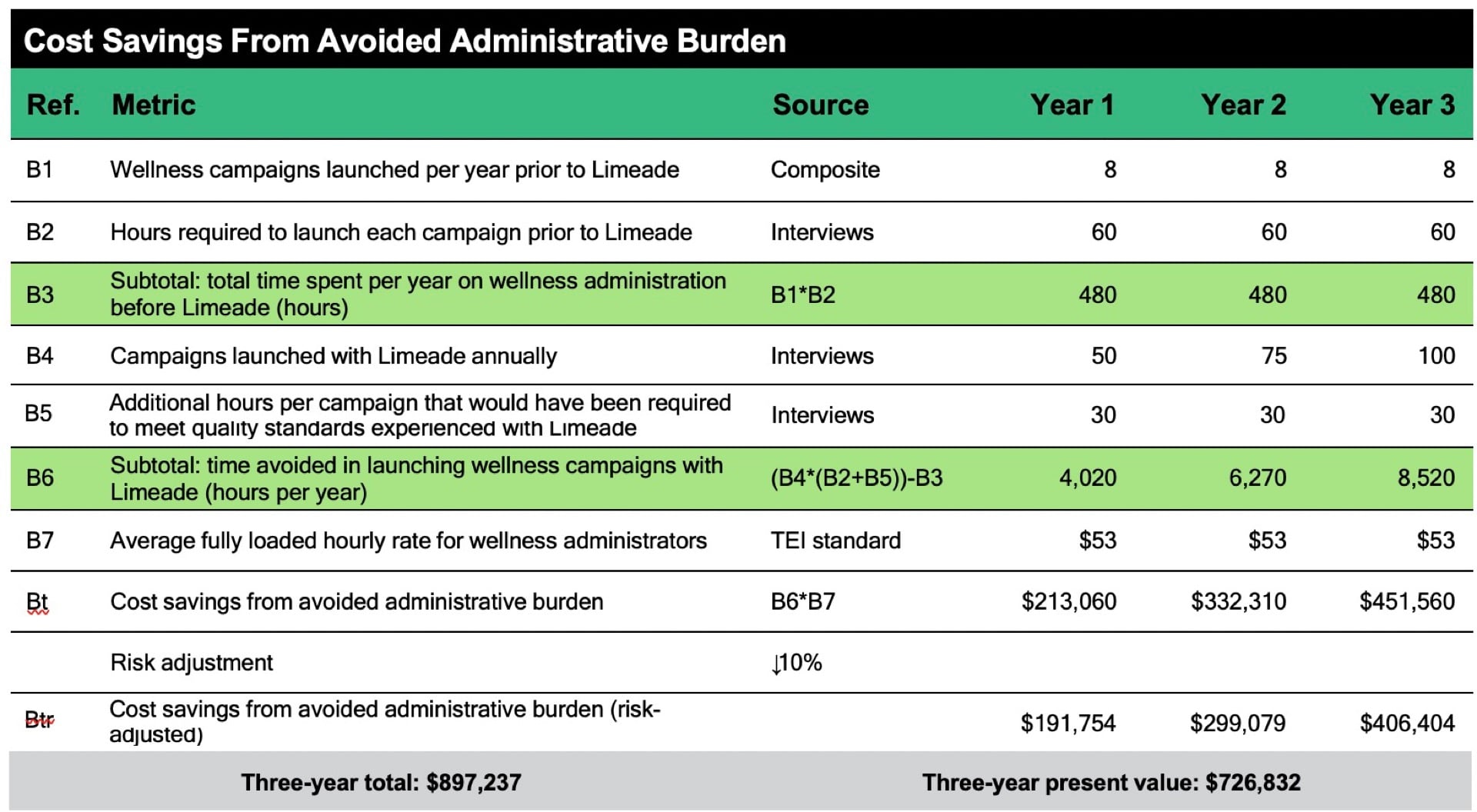
IMPROVED COST SAVINGS WITH BETTER BENEFIT UTILIZATION
Evidence and data. Data and insights provided through a Limeade solution are comprehensive and streamlined, including data and analysis from third-party wellness/well-being investments integrated into the Limeade solution. These insights allowed interviewees to optimize their budget against employee interests. Budget optimization took into consideration improved participation in ancillary benefits such as other well-being investments, including making the most of existing programming to maximize spend, doubling down on spend in areas of high interest, and eliminating poorly performing programs.
Modeling and assumptions. For the purposes of calculating the impact to ROI for the composite, Forrester assumes that the organization eliminates one dated wellness program per year based on low participation rates and recovers the annual costs to reallocate to other areas of well-being.
Risks. Improved cost savings with better benefit utilization may vary depending on the level of maturity and tenure of existing wellness program offerings, including ancillary benefits and the associated optimization opportunities.
Results. To account for these risks, Forrester adjusted this benefit downward by 5%, yielding a three-year, risk-adjusted total PV of more than $310,000.

UNQUANTIFIED BENEFITS
Additional benefits that customers experienced but were not able to quantify include:
- Optimized investment in Limeade and a flexible well-being solution that encouraged growth. Interviewees credited Limeade consultative services and flexible technology for laying a foundation for future growth at their organizations. Limeade worked together with organizations to help them leverage the benefits of having multiple integrations configured in the back end while meeting organizational data security standards and comfort levels. Additionally, Limeade’s customer success team identified areas of improvement and highlighted new Limeade capabilities or applications to maximize the investment.
- Improved employee satisfaction leading to more participation. Interviewees’ organizations experienced higher employee satisfaction ratings for users of their Limeade solution compared to their previous wellness platforms and tools. Interviewees indicated that their employees felt a sense of ownership over their well-being journeys that they did not experience with prior programs, which limited content, offered prescriptive guidance, and encouraged participation through incentives. With Limeade solutions, the employee experience was highly personalized, which improved satisfaction with the Limeade experience and resulted in higher participation.
- A director of communications and content at a healthcare organization explained how they measured participation with their Limeade solution, noting that 40% of Limeade users have a 30-day comeback period. They also indicated that they have seen higher response rates on well-being prompts since the investment in a Limeade solution.
- A senior benefits analyst from a conglomerate indicated that they have seen a 24% increase in Limeade assessment participation over the course of the investment. This confirmed that employees saw the value in participating in the well-being program.
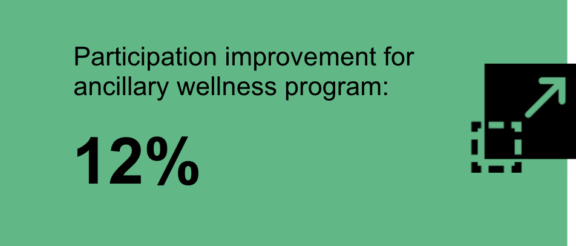
- Elevated participation in ancillary benefits. The Limeade solution became a hub for activities, content, updates, and other important communication at each of the interviewees’ organizations. As such, they were not solely focused on the content and activities generated by Limeade technology; they also enabled integrations into additional solutions in their wellness landscape. By bringing all the information together in one place, interviewees’ organizations improved participation in those ancillary areas as well.
- For example, manager of wellness at a professional services organization explained how they have seen improvement to well-being-related webinar participation by 4x. They attributed this to increased employee awareness and accessibility through the Limeade solution, which enabled them to inform a larger number of employees about the content and making it more convenient to participate. Additionally, the ability to tailor webinar content to employee interests through data insights on past participation areas and targeted communication to relevant employee groups ensured higher participation from the employees who would most benefit from the content.
- The senior benefits analyst at the conglomerate indicated that they saw improvements of 12% to participation in their financial well-being program, attributing the improvement to similar Limeade capabilities.
“[With Limeade], our employees better understand the brand and the messaging and therefore deliver more consistent experiences to patients, which is the best form of marketing and can lead to more patient admissions.”
Director of communications and content, healthcare
- Improved customer experiences. Forrester research indicates that there is no doubt that a key contributor to customer experience (CX) improvement is positive employee experience (EX). When employees are engaged and motivated, they want to do their best work for customers.12
- While the interviewees were unable to quantify the impact of improved customer experiences, Forrester measures this impact through resulting revenue improvement either from increased customer retention or improved repurchase rates. (See Appendix B for example calculations.)
- Built sustained healthy habits. Previous wellness programs had a singular focus on physical wellness and were driven by incentives, which did not encourage sustainable healthy habits. The nature of the wellness programming shifted with the Limeade solution. As a result, organizations noted that they have been able to stimulate positive changes in behaviors for their employees.
- A wellness program manager at a healthcare organization confirmed the shift in employee behavior: “There are people who will share as a result of participating in this challenge that they’ve changed a health behavior that they wouldn’t have been able to change without the tools and resources we provided to them from [Limeade].”
- While this is a positive benefit of investing in a Limeade solution in and of itself, logically, healthier habits lead to healthier Healthier employees can reduce spend on healthcare for organizations. While the interviewees were unable to quantify the impact of reduced healthcare costs for the purposes of the financial model, Forrester measures this impact through a reduction in the expected rise of annual healthcare costs. (See Appendix B for example calculations.)
FLEXIBILITY
The value of flexibility is unique to each customer. There are multiple scenarios in which a customer might implement Limeade and later realize additional uses and business opportunities. These opportunities come from a few different areas, including:
- Leveraged Limeade solution data and insights. The insights afforded through the solution allow organizations to continually tune their well-being focus to the needs of their employees. For example, a few of the interviewees noted an increased desire for mental health support among their employees. They then worked with their Limeade strategic account executive to figure out how to support their employees in this area with tools, resources, and functionality. This can also lead to other forms of cost avoidances down the road. A manager of wellness from a professional services organization described how they will leverage employee data to identify regional offices that would get the most out of amenities such as fitness centers. Making more-informed decisions about where to build out certain amenities will avoid costs associated with building and maintaining facilities in areas where they would go unused.
- Engaging with the Limeade Institute. While employee needs are one driver of well-being programming, another big component is the research conducted by the Limeade Institute. Limeade gives customers access to content and resources. Customers also leverage best practices gained from Limeade experience, including monthly or quarterly activities that encourage employee adoption and consistent participation.
Flexibility would also be quantified when evaluated as part of a specific project (described in more detail in Appendix A).
Analysis Of Costs
ANNUAL COSTS TO LIMEADE
Evidence and data. Interviewees entered a three-year contract with Limeade that is paid on an annual subscription basis and calculated per employee, per year. Annual subscription costs included:
- Limeade Well-Being solution in 19 languages (other languages added over time are also included)
- Implementation (including scoped Integrations)
- Support
- Dedicated customer success
- Team of technical experts for integrations
Modeling and assumptions. For the purposes of the composite, Forrester assumes the following:
- Annual fees to Limeade are calculated based on the assumed 30,000 employees at the composite organization and result in a $28 PEPY price.
- Pricing may vary. Contact Limeade for additional details.
Results. To account for cost variations, Forrester adjusted this cost upward by 5%, yielding a three-year, risk-adjusted total PV (discounted at 10%) of $2.2 million.

INTERNAL RESOURCE TIME SPENT ON IMPLEMENTATION, PROGRAM ADMINISTRATION, AND MAINTENANCE
Evidence and data. Interviewees indicated that most internal resource time was primarily spent by technical resources on implementation and platform maintenance, as well as by wellness program administrators on program administration.
The interviewees’ organizations also utilized their Limeade customer success team to launch most of their campaigns, events, and activities. Doing so allowed them to focus internal resource time and efforts on program strategy and the orchestration of a “well-being champion network.” Champions were line-of-business stakeholders distributed throughout the organization. Champions communicated to their individual business lines and regional offices about available solution offerings and assisted in some content creation. Interviewees noted that champions had a huge impact on the effectiveness of the wellness program and employee engagement in it.
Modeling and assumptions. For the purposes of the composite, Forrester makes the following assumptions:
- The resources involved in Limeade solution implementation efforts comprise both technology and wellness program administration roles. Collectively, time spent on implementation tasks in the three-month period total one FTE’s time.
- Similarly, ongoing maintenance and program administration requires technology FTEs as well as wellness program administration FTEs. Three FTEs from both operational areas spend 10% to 15% of their time on ongoing Limeade investment-related activities. The percentage of time dedicated to these activities increases over the three-year investment period to account for more robust platform offerings as well as higher employee engagement in the experience.
- Additionally, the champion network program grows from 25 line-of-business stakeholders to 50 stakeholders by Year 3. Each champion is expected to spend 12 hours annually on well-being-related activities.
- The average fully burdened annual salary for a line-of-business stakeholder champion is $150,000, or $72 per hour.
Risks. Internal resource time spent on Limeade solution implementation and ongoing maintenance and administration may vary depending on the following:
- The size and scope of the initial implementation project will impact how much internal resource time is required as well as the implementation timeline.
- Employee engagement in the Limeade solution and the organization’s appetite for additional capabilities, integrations, and content will impact ongoing resource time spent on solution maintenance and program administration.
- Additionally, the size and nature of the champion network program may vary across organizations as well as within organizations across different regional areas and business units.
- Finally, fully burdened annual salaries and calculated hourly rates will vary depending on resource types and levels within the organization as well as market fluctuations and regional averages.
Results. To account for these risks, Forrester adjusted this cost upward by 5%, yielding a three-year, risk-adjusted total PV of $215,000.

Financial Summary
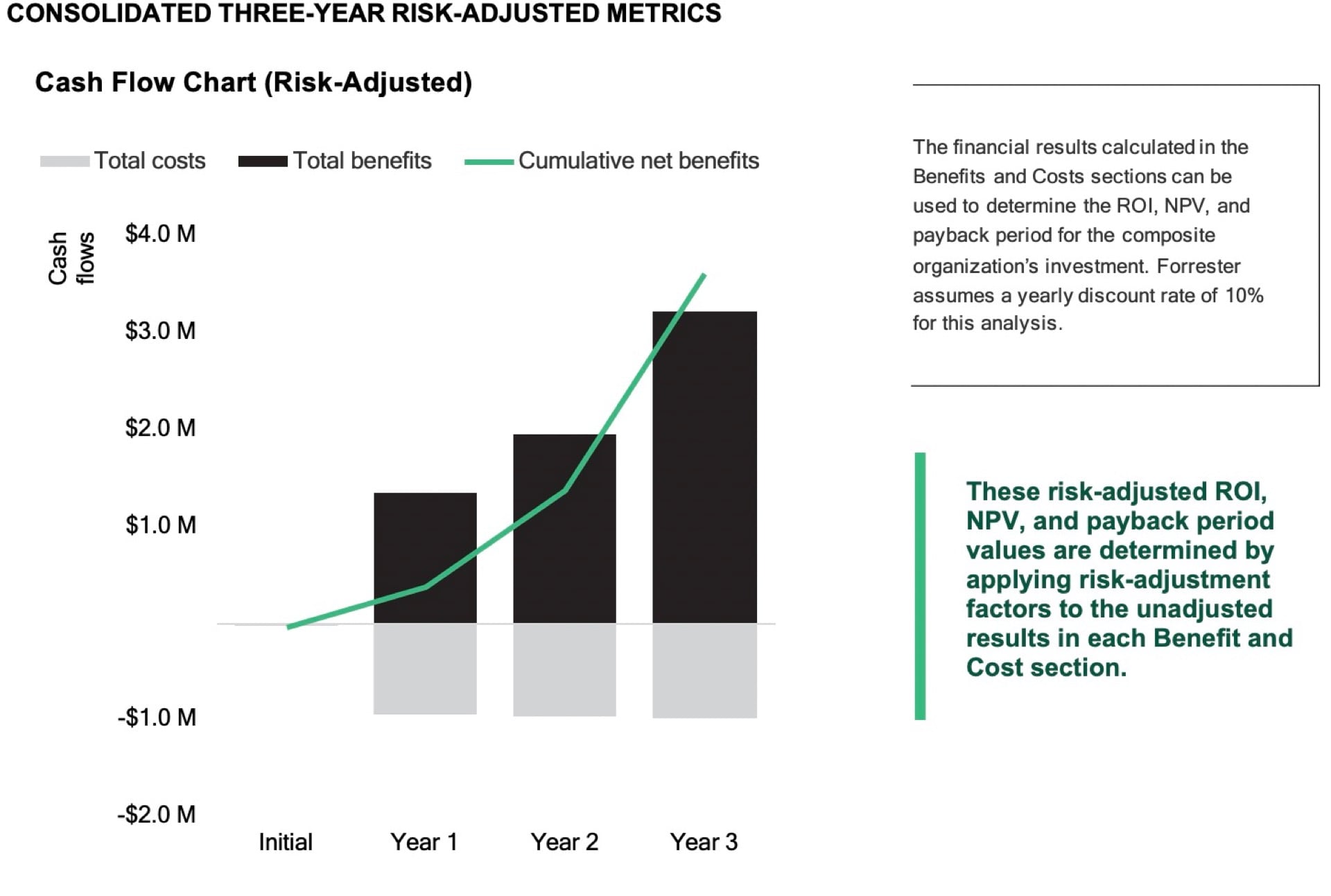

Click here to download the PDF version.
Appendix A:
Total Economic Impact is a methodology developed by Forrester Research that enhances a company’s technology decision-making processes and assists vendors in communicating the value proposition of their products and services to clients. The TEI methodology helps companies demonstrate, justify, and realize the tangible value of IT initiatives to both senior management and other key business stakeholders.
TOTAL ECONOMIC IMPACT APPROACH
Benefits represent the value delivered to the business by the product. The TEI methodology places equal weight on the measure of benefits and the measure of costs, allowing for a full examination of the effect of the technology on the entire organization.
Costs consider all expenses necessary to deliver the proposed value, or benefits, of the product. The cost category within TEI captures incremental costs over the existing environment for ongoing costs associated with the solution.
Flexibility represents the strategic value that can be obtained for some future additional investment building on top of the initial investment already made. Having the ability to capture that benefit has a PV that can be estimated.
Risks measure the uncertainty of benefit and cost estimates given: 1) the likelihood that estimates will meet original projections and 2) the likelihood that estimates will be tracked over time. TEI risk factors are based on “triangular distribution”.
PRESENT VALUE (PV)
The present or current value of (discounted) cost and benefit estimates given at an interest rate (the discount rate). The PV of costs and benefits feed into the total NPV of cash flows.
NET PRESENT VALUE (NPV)
The present or current value of (discounted) future net cash flows given an interest rate (the discount rate). A positive project NPV normally indicates that the investment should be made unless other projects have higher NPVs.
RETURN ON INVESTMENT (ROI)
A project’s expected return in percentage terms. ROI is calculated by dividing net benefits (benefits less costs) by costs.
DISCOUNT RATE
The interest rate used in cash flow analysis to take into account the time value of money. Organizations typically use discount rates between 8% and 16%.
PAYBACK PERIOD
The breakeven point for an investment. This is the point in time at which net benefits (benefits minus costs) equal initial investment or cost.
The initial investment column contains costs incurred at “time 0” or at the beginning of Year 1 that are not discounted. All other cash flows are discounted using the discount rate at the end of the year. PV calculations are calculated for each total cost and benefit estimate. NPV calculations in the summary tables are the sum of the initial investment and the discounted cash flows in each year. Sums and present value calculations of the Total Benefits, Total Costs, and Cash Flow tables may not exactly add up, as some rounding may occur.
Appendix B: Supplemental Material
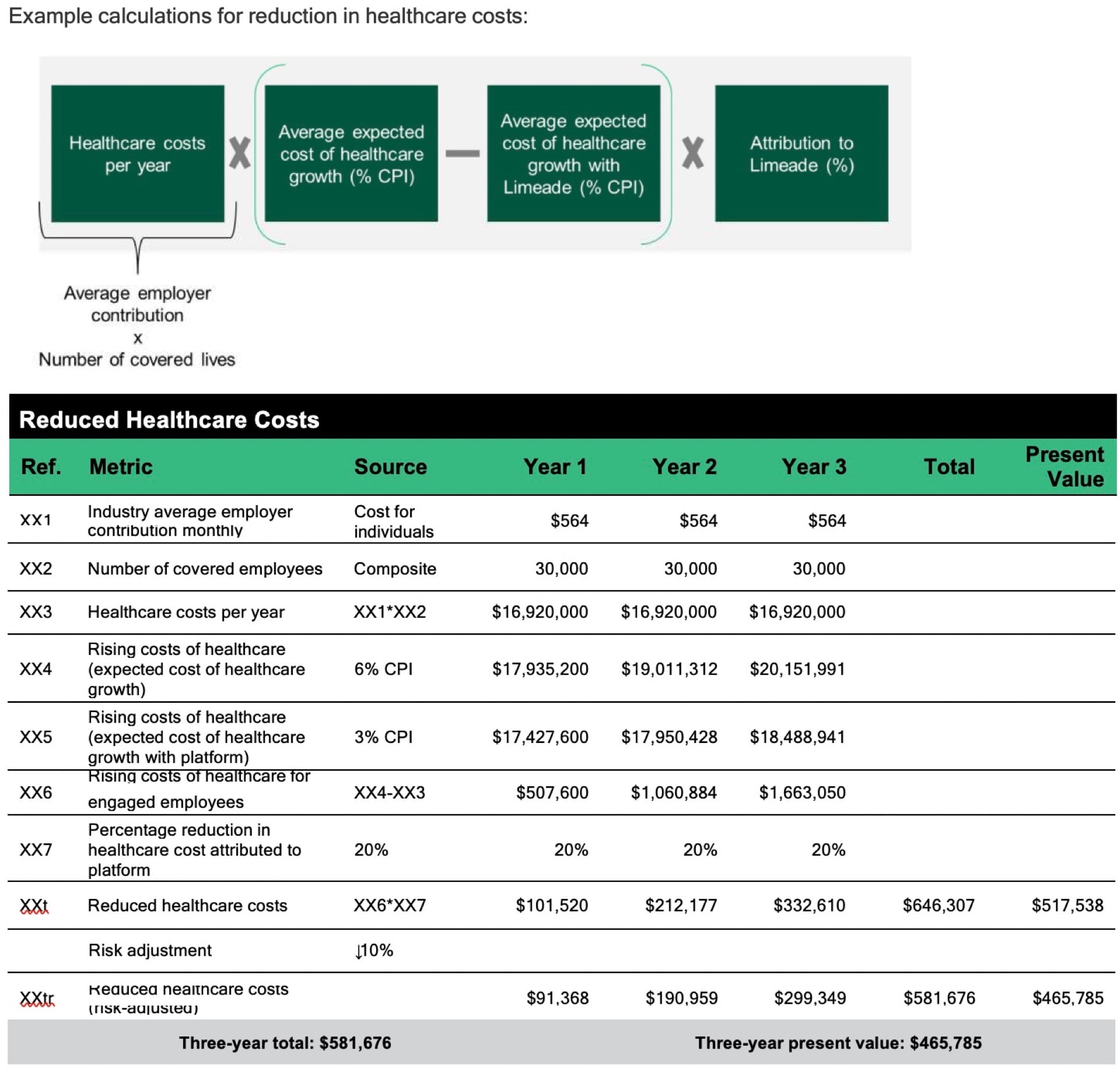
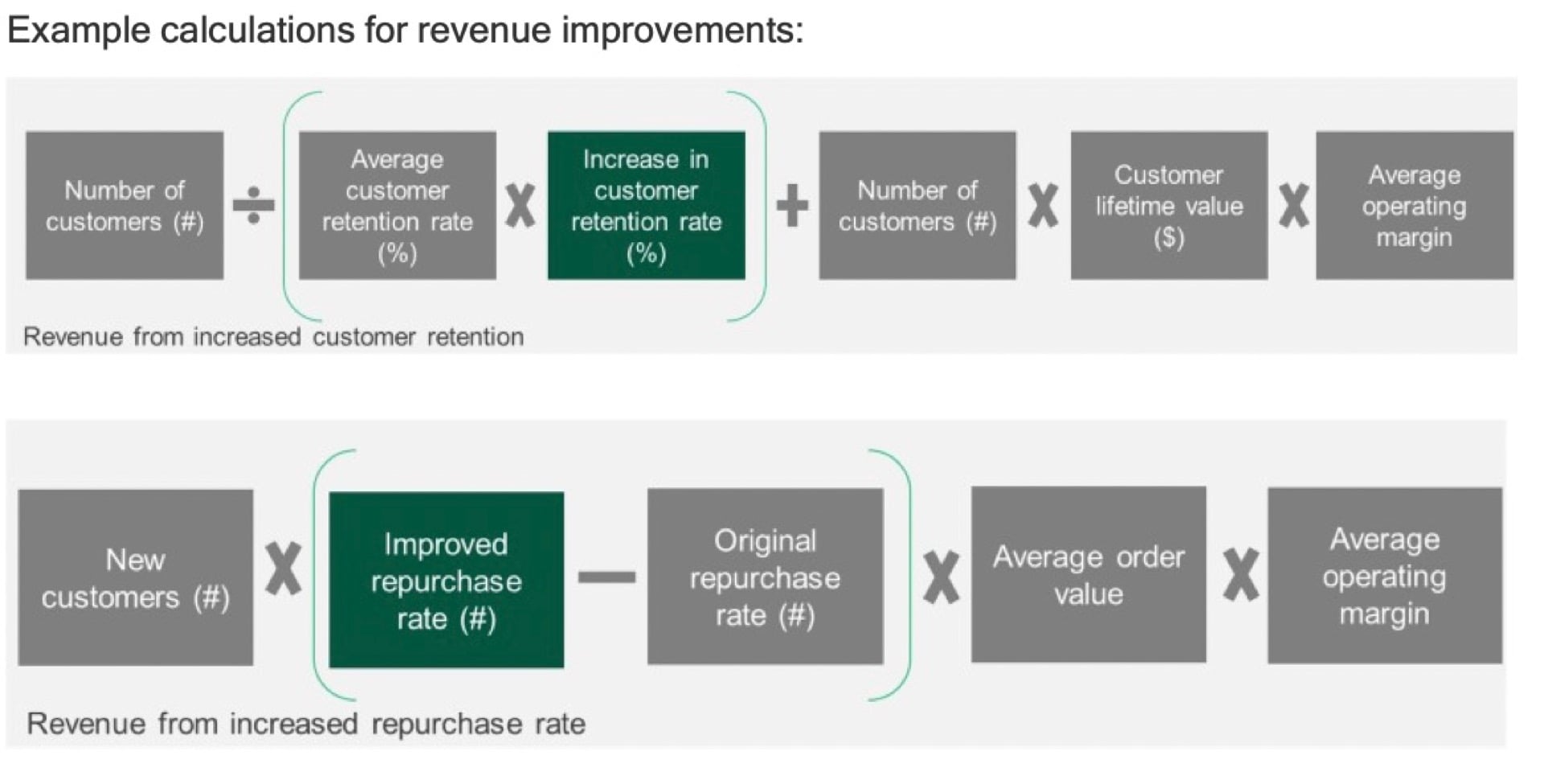
Appendix C: Endnotes
1 Source: “Use Digital Technologies To Improve Employee Engagement,” Forrester Research, Inc., April 19, 2016.
2 Total Economic Impact is a methodology developed by Forrester Research that enhances a company’s technology decision-making processes and assists vendors in communicating the value proposition of their products and services to clients. The TEI methodology helps companies demonstrate, justify, and realize the tangible value of IT initiatives to both senior management and other key business stakeholders.
3 Source: “Take Employee Wellness Beyond Benefits,” Forrester Research, Inc., June 18, 2021.
4 Source: “The ROI Of EX,” Forrester Research, Inc., September 3, 2019.
5 Source: “Take Employee Wellness Beyond Benefits,” Forrester Research, Inc., June 18, 2021.
6 Source: “Mental Health, Substance Use, and Suicidal Ideation During the COVID-19 Pandemic,” Centers for Disease Control and Prevention, August 14 2020.
7 Source: “Take Employee Wellness Beyond Benefits,” Forrester Research, Inc., June 18, 2021.
8 Ibid.
9 Ibid.
10 Source: “Forrester’s EX Index: A Deeper Look At The Data,” Forrester Research, Inc., March 4, 2020.
11 Source: “The People Leader’s Guide To Burnout,” Forrester Research, Inc., January 11, 2022.
12 Source: “Understand The Differences Between EX And CX,” Forrester Research, Inc., August 2, 2021.
Continue Reading
Fill out the form to continue reading
Explore more insights from Limeade

Reading List
17 books to cultivate professional and personal self-care from the inside out
There's no better time than now to focus on what matters most — you. These must-reads will arm you on the road to self-care — both at home and at work.

Guide
5 ways to create a personalized employee experience
Enter the new era of personalized well-being — a seamless employee experience that reflects who each employee is and how they work.

Guide
Employee engagement software: Your ultimate guide
Improving employee engagement has been shown to increase profitability, improve retention, and attract higher-quality employees – making employee engagement software a pivotal part of office life and culture. But getting started and finding all the right information on which software to choose can seem like a daunting task.

Guide
How to build a business case for employee wellness programs
This guide walks through the importance of a wellness program, the information you need to build a business case for an employee wellness program, and the cost savings and business benefits enabled by a holistic approach to well-being with Limeade.

